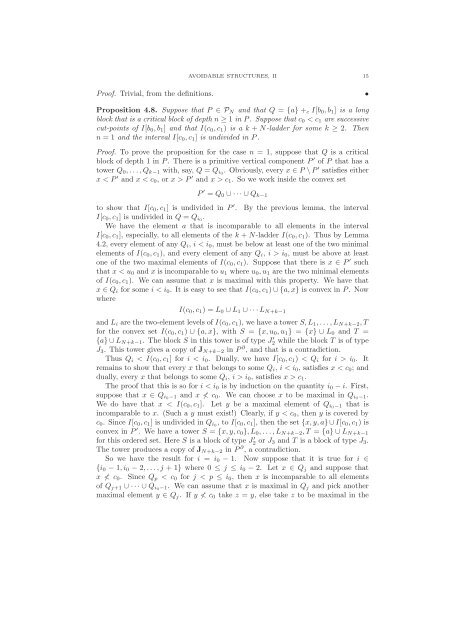Avoidable structures, II: finite distributive lattices and nicely ...
Avoidable structures, II: finite distributive lattices and nicely ...
Avoidable structures, II: finite distributive lattices and nicely ...
Create successful ePaper yourself
Turn your PDF publications into a flip-book with our unique Google optimized e-Paper software.
AVOIDABLE STRUCTURES, <strong>II</strong> 15<br />
Proof. Trivial, from the definitions.<br />
•<br />
Proposition 4.8. Suppose that P ∈ P N <strong>and</strong> that Q = {a} + c I[b 0 ,b 1 ] is a long<br />
block that is a critical block of depth n ≥ 1 in P. Suppose that c 0 < c 1 are successive<br />
cut-points of I[b 0 ,b 1 ] <strong>and</strong> that I(c 0 ,c 1 ) is a k + N-ladder for some k ≥ 2. Then<br />
n = 1 <strong>and</strong> the interval I[c 0 ,c 1 ] is undivided in P.<br />
Proof. To prove the proposition for the case n = 1, suppose that Q is a critical<br />
block of depth 1 in P. There is a primitive vertical component P ′ of P that has a<br />
tower Q 0 ,...,Q k−1 with, say, Q = Q i0 . Obviously, every x ∈ P \P ′ satisfies either<br />
x < P ′ <strong>and</strong> x < c 0 , or x > P ′ <strong>and</strong> x > c 1 . So we work inside the convex set<br />
P ′ = Q 0 ∪···∪Q k−1<br />
to show that I[c 0 ,c 1 ] is undivided in P ′ . By the previous lemma, the interval<br />
I[c 0 ,c 1 ] is undivided in Q = Q i0 .<br />
We have the element a that is incomparable to all elements in the interval<br />
I[c 0 ,c 1 ], especially, to all elements of the k +N-ladder I(c 0 ,c 1 ). Thus by Lemma<br />
4.2, every element of any Q i , i < i 0 , must be below at least one of the two minimal<br />
elements of I(c 0 ,c 1 ), <strong>and</strong> every element of any Q i , i > i 0 , must be above at least<br />
one of the two maximal elements of I(c 0 ,c 1 ). Suppose that there is x ∈ P ′ such<br />
that x < u 0 <strong>and</strong> x is incomparable to u 1 where u 0 ,u 1 are the two minimal elements<br />
of I(c 0 ,c 1 ). We can assume that x is maximal with this property. We have that<br />
x ∈ Q i for some i < i 0 . It is easy to see that I(c 0 ,c 1 )∪{a,x} is convex in P. Now<br />
where<br />
I(c 0 ,c 1 ) = L 0 ∪L 1 ∪···L N+k−1<br />
<strong>and</strong> L i are the two-element levels of I(c 0 ,c 1 ), we have a tower S,L 1 ,...,L N+k−2 ,T<br />
for the convex set I(c 0 ,c 1 ) ∪ {a,x}, with S = {x,u 0 ,u 1 } = {x} ∪ L 0 <strong>and</strong> T =<br />
{a}∪L N+k−1 . The block S in this tower is of type J ′ 2 while the block T is of type<br />
J 3 . This tower gives a copy of J N+k−2 in P ∂ , <strong>and</strong> that is a contradiction.<br />
Thus Q i < I(c 0 ,c 1 ] for i < i 0 . Dually, we have I[c 0 ,c 1 ) < Q i for i > i 0 . It<br />
remains to show that every x that belongs to some Q i , i < i 0 , satisfies x < c 0 ; <strong>and</strong><br />
dually, every x that belongs to some Q i , i > i 0 , satisfies x > c 1 .<br />
The proof that this is so for i < i 0 is by induction on the quantity i 0 −i. First,<br />
suppose that x ∈ Q i0−1 <strong>and</strong> x ≮ c 0 . We can choose x to be maximal in Q i0−1.<br />
We do have that x < I(c 0 ,c 1 ]. Let y be a maximal element of Q i0−1 that is<br />
incomparable to x. (Such a y must exist!) Clearly, if y < c 0 , then y is covered by<br />
c 0 . Since I[c 0 ,c 1 ] is undivided in Q i0 , to I[c 0 ,c 1 ], then the set {x,y,a}∪I[c 0 ,c 1 ) is<br />
convex in P ′ . We have a tower S = {x,y,c 0 },L 0 ,...,L N+k−2 ,T = {a}∪L N+k−1<br />
for this ordered set. Here S is a block of type J ′ 2 or J 3 <strong>and</strong> T is a block of type J 3 .<br />
The tower produces a copy of J N+k−2 in P ∂ , a contradiction.<br />
So we have the result for i = i 0 − 1. Now suppose that it is true for i ∈<br />
{i 0 − 1,i 0 − 2,...,j + 1} where 0 ≤ j ≤ i 0 − 2. Let x ∈ Q j <strong>and</strong> suppose that<br />
x ≮ c 0 . Since Q p < c 0 for j < p ≤ i 0 , then x is incomparable to all elements<br />
of Q j+1 ∪ ··· ∪ Q i0−1. We can assume that x is maximal in Q j <strong>and</strong> pick another<br />
maximal element y ∈ Q j . If y ≮ c 0 take z = y, else take z to be maximal in the
















